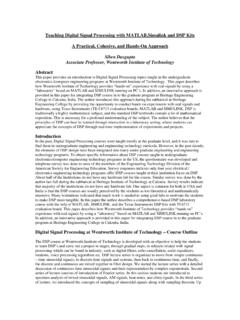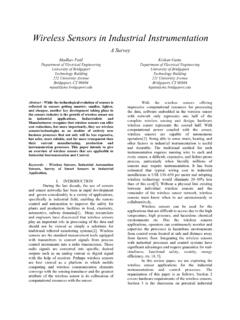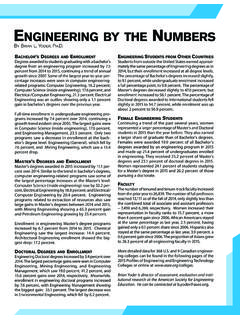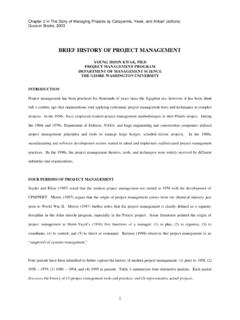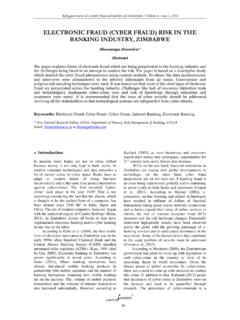Transcription of ERP Systems and their Effects on Organizations: A Proposed ...
1 ASEE 2014 Zone I Conference, April 3-5, 2014, University of Bridgeport, Bridgeport, CT, USA. ERP Systems and their Effects on Organizations: A Proposed Scheme for ERP Success Khaled Almgren Computer Science and Engineering Department University of Bridgeport Bridgeport, United States Cristian Bach Technology Management Department University of Bridgeport Bridgeport, United States Abstract The world has become more digitized. Businesses are depending on technology to help them enhance their business processes. Companies are looking for an information system that can handle massive workloads. This is where Enterprise Resource Planning (ERP) Systems come into play.
2 An ERP integrates different subsystems into one huge system that shares one database. It enhances productivity and brings more profit to companies (Hasselbring, 2000). The purpose of this paper is to address the Effects of ERP Systems on organizations. The paper will discuss these issues and present a scheme to overcome them. Research was carried out with articles, as well as books, to gather the suitable resources that will help us in discussing the factors that contribute to ERP Systems . Many of the articles are from IEEE journals. A large volume of data was collected that represents millions of users. Analyzing the collected data will give researchers insight into the Effects brought about by ERP Systems .
3 In addition, the paper will explore these issues and their impacts on organizations. Keywords Enterprise Resource Planning. Customization. Information System. I. INTRODUCTION Since the beginning of organizations, methods were researched to improve business processes. This is when computer Systems and databases were introduced to the business world. Creating an information system helps the organization to maintain its data and use its processes. At first, it was a great idea to have a computer perform a process much faster than a human can do. It was also unbelievable to store millions of papers into a drive that is smaller than a human s head.
4 However, when businesses started growing more, the need for computer Systems has increased. Then, different Systems were introduced. But many problems have arisen (Irani, 2002). It was in the beginning of the 1990s when the enterprise resource planning (ERP) system was first introduced. From the perspective of the business field, it was a great product. But from the perspective of system developers, it was a challenge to implement. The ERP system is not only about integrating different subsystems into one massive system; it is much more than that. It is a system whereby you have an entire electronic organization . However, everything new brings new challenges. ERP has not only brought obstacles to system developers, but to organizations, as well (McGaughey & Gunasekaran, 2007).
5 The ERP system stands for enterprise resource planning. It is basically an information system that combines different subsystems into one system. This operation is called integration, whereby subsystems are integrated into one system. For example, an organization has three main information Systems . The first system handles human resources; the second system handles finance; and the third system handles manufacturing. ERP integrates these three subsystems into one system that shares data among these subsystems. The ERP system should improve efficiency for organizations (McGaughey & Gunasekaran, 2007). The traditional ERP system is called a back-office system.
6 It is used exclusively by employees and is not for the public or customers. It involves only the core business processes of organizations without involving customers. The main goal of the traditional ERP system is only to improve efficiency (McGaughey & Gunasekaran, 2007). However, the modern ERP system has broken the boundaries of the back office (Robert Jacobs, 2007) to also include the front office, such as customers. It includes the usage of customers to make it a greater system that handles massive operations (Robert Jacobs, 2007). The history of ERP Systems actually dates back to 1970, with the need for the integration of business processes. But it was not implemented until the beginning of the 1990s.
7 The name itself came about in 1990 by Gartner Group. Software companies started to implement ERP Systems in the early 1990s, such as Baan software and SAP (Robert Jacobs, 2007). SAP released SAP s R/3 in 1992. The system added new features, such as the addition of client-server hardware architecture. The addition of client-server hardware architecture enabled the software to be run on many platforms. Moreover, the system was implemented using an open architecture approach that made it possible for third-party companies to integrate their Systems with SAP s R/3. In 1999, the ERP system made companies, except for IBM, grow much more and control the software market, such as Oracle, SAP, PeopleSoft, and BAAN (Robert Jacobs, 2007).
8 The year 2000 is one reason why ERP Systems have spread around the world. ERP system vendors have addressed the issue of Y2K. These companies and other major ERP Systems have implemented packages, such as a system package for universities. Third-party companies customize these packages (Robert Jacobs, 2007). The ERP system brings many benefits to organizations. It brings operations benefits, managerial benefits, strategic benefits, IT infrastructure benefits, and organization benefits. But there are many obstacles to moving to an ERP system (Shang & Seddon). I. RELATED WORK In order to make an ERP implementation a success, we need a good scheme.
9 Limited studies were conducted in ERP implementation plans. Two of these implementation schemes will be discussed in this section. Most of the studies focus on the critical success factors of ERP success. There are many factors involved in making the ERP project a success. There are critical factors (Velcu, 2007). These factors will be discussed in this section. According to Umble, there are nine success critical factors. The first one is a clear understanding of strategic goals. This is the first factor because you need to understand why you want to change to ERP. This factor means that the organization needs to understand what they want to achieve and how they can achieve it.
10 In order to do that, they need to understand the strategic goals (Umble, Haft, & Umble, 2003). The second factor is commitment by top management. This is very important. The members of top management in any organization are the decision makers. And in order to make the ERP project work, it needs full support from top management (Umble, et al., 2003). The third factor is excellent project management. A great project management strategy needs to be followed in order to reach success. This involves a clear understanding and definition of objectives. They need to have good work and resource plans. In conclusion, the management needs to track the project progression (Umble, et al.)


